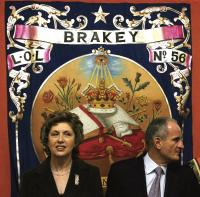Southern Orange commemorations, past and present
Published in 20th-century / Contemporary History, Issue 5 (Sept/Oct 2012), News, Volume 20
‘It is possible to be both Irish and British, possible to be both Orange and Irish’—President Mary McAleese (and husband Martin) at Brakey Orange Hall, Baileborough, Co. Cavan, on 27 November 2008, the first such visit by an Irish president. (PA)
On 3 July 2012 Drew Nelson, grand secretary of the Grand Orange Lodge of Ireland, became the first member of the Orange Order to formally address the Irish Oireachtas when he accepted an invitation to speak to members of the Senate. Just over a week later, on 12 July, President Michael D. Higgins hosted a reception, which included southern Orangemen, at Áras an Uachtaráin to mark the anniversary of the Battle of the Boyne—the only government-sponsored commemoration of this battle anywhere in Ireland. These events reflect new efforts on the part of the Orange Order to relate to the institutions of the Irish state. They reflect also a new willingness in official and other circles to promote a more pluralist approach to all the citizens of the country. Following partition, Orange demonstrations continued to be held in counties Donegal, Monaghan and Cavan. At an Orange parade in Clones, Co. Monaghan, in July 1923, a spokesman declared that ‘they did not desire to be placed under their present regime, but they paid tribute to whom tribute was due’. The year 1931, however, was the last time that Orange demonstrations took place in counties Monaghan and Cavan. A month after Twelfth of July celebrations in 1931 a large body of republicans, including IRA units, occupied Cootehill, Co. Monaghan, on the eve of a planned demonstration by members of the Royal Black Institution, a sister organisation to the Orange Order. The state authorities reacted strongly, dispatching troops and extra police to Cootehill to restore law and order. Although the demonstration did not proceed, the government gave assurances to local Orange and Black leaders that their parades would be protected in future. The following year, however, de Valera and a Fianna Fáil government were in power and such assurances were no longer forthcoming. The minutes of the County Monaghan Grand Lodge show that in June 1932 members received information that armed interference by local republicans was planned against their proposed county demonstration, and consequently all parades that year were cancelled in the border counties, except at Pettigo, Co. Donegal.Thereafter, lodges in counties Monaghan and Cavan held small-scale parades to churches and private meetings but were not able to hold major demonstrations in their own counties, for fear of the consequences. Lodges now attended parades in Northern Ireland on the Twelfth of July. Later in the 1930s, July Orange marches resumed in County Donegal but only at the remote coastal area of Rossnowlagh.By the 1960s the situation regarding Orange parades in the Republic had changed little. Most southern Orange members marched in Northern Ireland at the July demonstrations. In 1960 the Belfast parade was led by a ‘small but proudly marching group from Dublin and Wicklow’. The only parade in the South was at Rossnowlagh. In 1970, however, the parade at Rossnowlagh was cancelled, owing to a threat made by Senator Bernard McGlinchey at a meeting of Donegal County Council. The matter was raised in the Dáil, where Desmond O’Malley, minister for justice, strongly backed the right of Donegal Orangemen to parade. In a remarkable speech for the time he declared:
‘That these traditions are not those of the great majority in the locality in no way diminishes the right of those who adhere to them to express themselves. Rather does it place on the majority a special obligation to ensure that their right is respected and upheld and to ensure that it is seen to be a right and not something that is only tolerated.’
Nonetheless, the next parade at Rossnowlagh wasn’t until 1978. At first the revived parade involved small numbers, but attendance grew, partly because it was held on the Saturday before the Twelfth, so attracting more southern and northern lodges.For southern Orangemen, however, the most important change came with the election in 1997 of Mary McAleese as Irish president. In her inaugural speech she declared that the theme of her presidency would be ‘building bridges’ and it soon became clear that this included members of the Orange Order in the Republic. On 11 July 1998, President McAleese hosted a reception at Áras an Uachtaráin to honour the southern Protestant community, particularly the Orangemen, many of whom were invited to the occasion. From then, for the rest of her term in office, to mark the anniversary of the Battle of the Boyne she held a reception every July, involving southern Orangemen, their families and others. On 27 November 2008 President McAleese visited Brakey Orange Hall, Baileborough, Co. Cavan, the first such visit by an Irish president. Very significantly, she declared: ‘It is possible to be both Irish and British, possible to be both Orange and Irish’. At the Rossnowlagh demonstration in 2010, Orange Grand Chaplain Revd Stanley Gamble acknowledged the work of President McAleese and stated that she had made Ireland a ‘warm house for Protestants’. The recent visit of Drew Nelson to the Irish Senate, and the reception this Twelfth of July to mark the anniversary of the Battle of the Boyne at Áras an Uachtaráin, hosted by President Michael D. Higgins, reflect continued efforts to create a pluralist society in Ireland. HI
Brian M. Walker is Professor Emeritus of Irish Studies at Queen’s University, Belfast. His A political history of the two Irelands: from partition to peace (Palgrave Macmillan) has just been published.
















